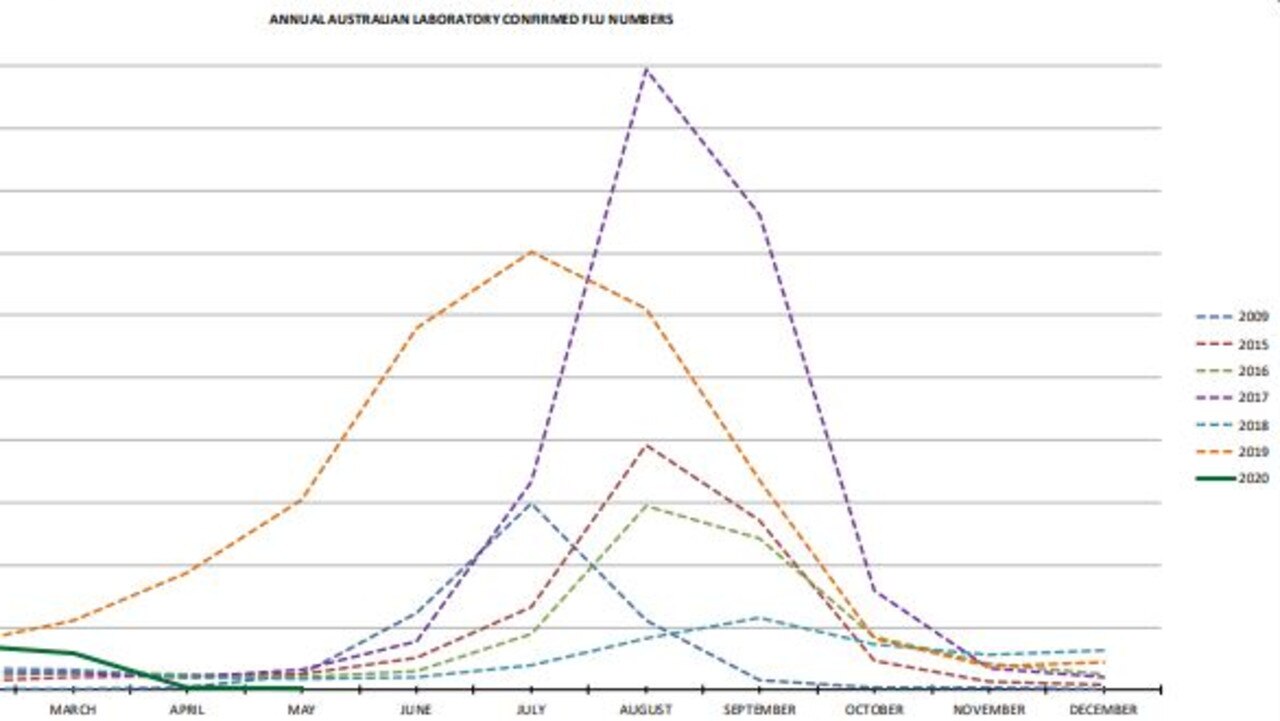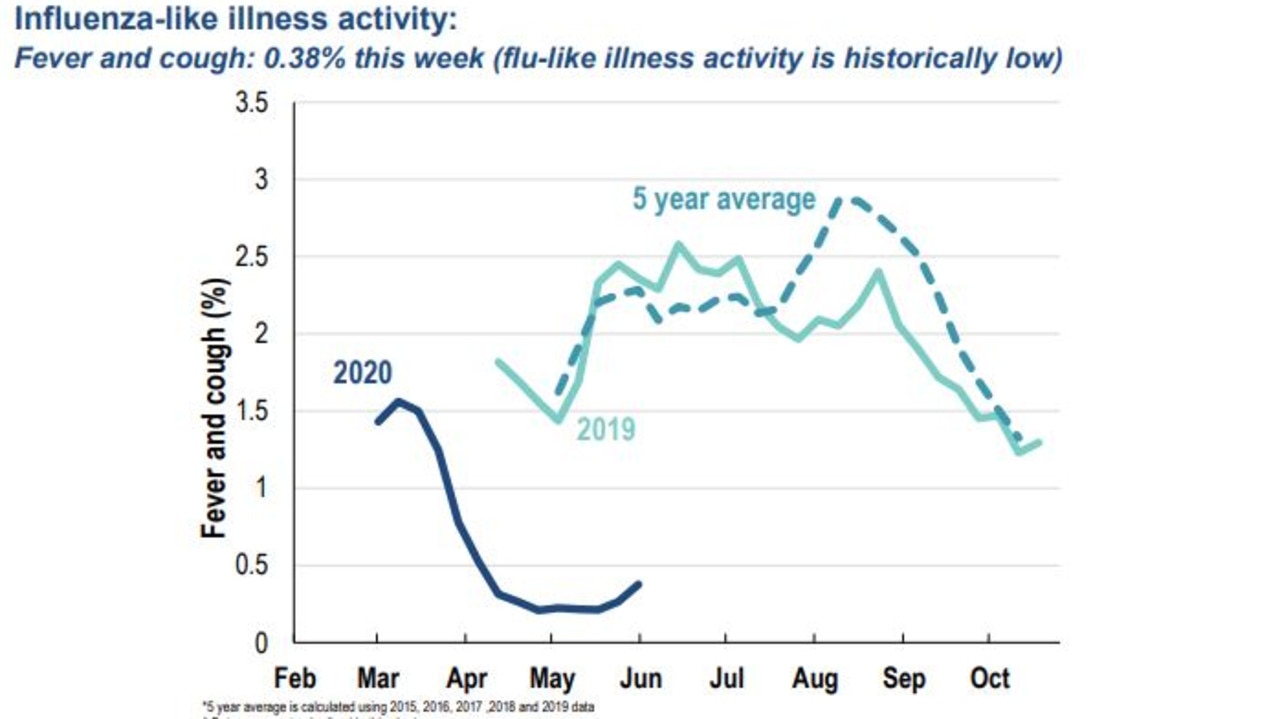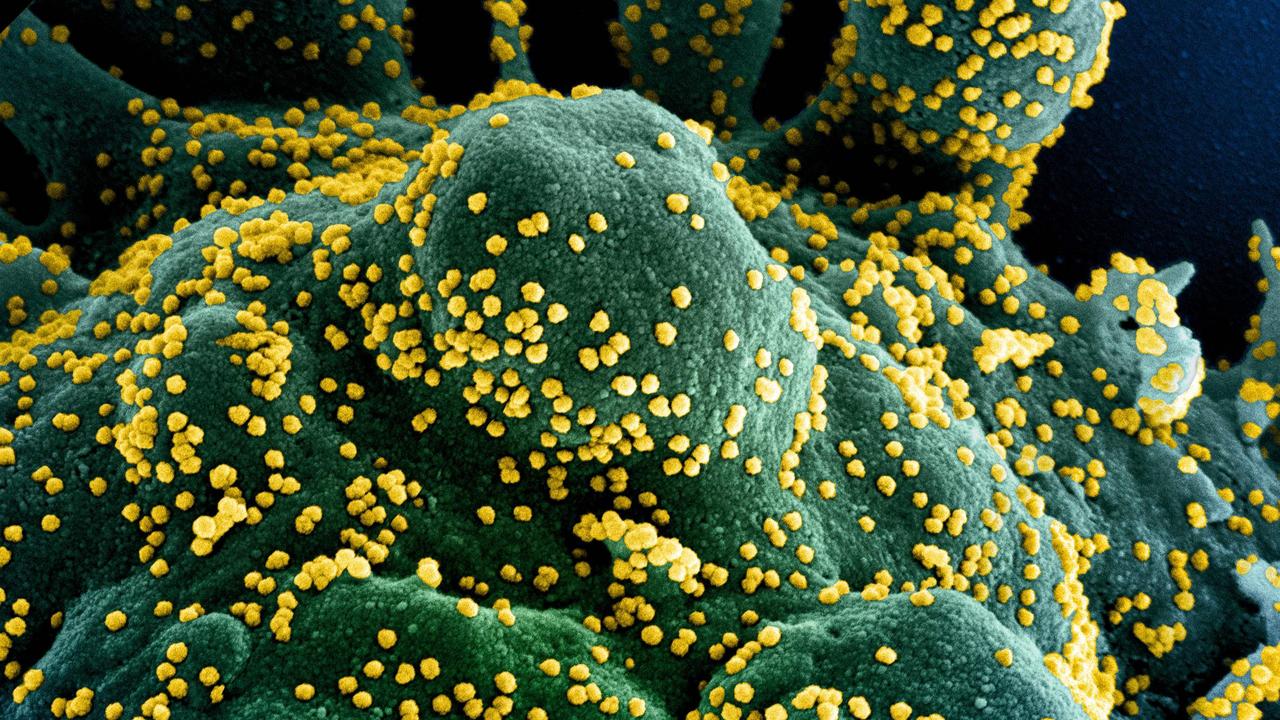Low flu numbers a positive side effect of COVID-19 lockdown in Australia
Lockdown and social distancing measures introduced to stem the spread of coronavirus may have helped suppress this year’s flu season.

Lockdown and social distancing measures introduced to stem the spread of coronavirus around Australia may have been a thorn in our side, but our “tremendous success” so far to flatten the curve could play a hand in keeping us healthy from other flu-like illnesses in coming months.
Data from the Immunisation Coalition’s Influenza Activity Surveillance 2020 and the FluTracking surveillance system suggest the nationwide restrictions – which banned non-essential gatherings and closed our national and (most) state borders – have suppressed our flu season in some months by more than 90 per cent.
Based on figures in January and February, Australia was set to repeat its record-breaking number of flu cases in 2019, virologist and Associate Professor at the University of Queensland, Ian Mackay, told news.com.au.
According to FluTracking data, which surveys around 70,000 Australians each week and records their flu-like symptoms, there were 6962 laboratory-confirmed flu cases in January and 7161 in February.
RELATED: Follow the latest coronavirus updates
RELATED: Australian world-first virus breakthrough

But cases nosedived in March, when the National Cabinet began to implement its coronavirus shutdown.
“After measures were rolled out to combat COVID-19, those flu numbers dropped to historic lows,” Professor Mackay explained.
“Because we know flu testing is still going on, we can say that the physical separation of humans and the focus on hygiene measures have also kept us safe from flu.”
Numbers in March were followed by an even more dramatic drop in April – 307 laboratory-confirmed cases compared to 18,691 at the same time last year.
Prof Mackay said the statistics are a silver lining of a “horrible situation”.
“Flu has a big economic and personal impact every year so this is a good outcome from a horrible situation,” he said.
“Physical distancing is a primitive measure, but it’s clearly helped crush the spread of a lot of respiratory viruses in Australia.”
RELATED: The nations where virus is growing

FluTracking survey co-ordinator, Dr Craig Dalton, told the ABC social distancing measures implemented Australia-wide may have averted a “public health disaster”.
“The social distancing the community has taken up leads to fewer opportunities to transmit viruses between people, so few people are infected and fewer people get sick,” he said.
“The rapid social distancing by the general community may have averted a public health disaster.”
Prof Mackay said taking advantage of flu vaccinations – which experts urged everyone over the age of six months to get in April, ahead of the typical flu season in winter – were our “best bet” in keeping numbers low.
“Vaccination can help protect us against the influenza virus as we begin to mingle again,” he said.
“The flu viruses are still around in the world, just in low numbers and travellers still returning to Australia from overseas. There is a lot of vaccine available and it is our best bet to prevent severe flu.”
Director of Aged Care Research and the Head of Memory Clinic at Austin Health, Professor Michael Woodward, said it was not the time to be complacent about the significant impact of influenza on the Australian health system, and intensive care units.
“Vaccinating for flu is always important – but this year it will be particularly critical, and especially for older Australians and those with chronic diseases,” he said.
“While the flu vaccine does not protect against the COVID-19 virus, immunising against the flu – particularly in high-risk groups like those aged 65 and over – may help to reduce the risk of diagnostic uncertainty between flu and COVID-19 and reduce pressure on our health system.”
RELATED: Coronavirus suddenly acting differently
There’s a potential downside to all of this reduced infection, Dr Dalton warned – a hit to herd immunity for seasonal flus, which he likened to prescribed burning in bushfires.
“A useful metaphor is fuel for bushfires – if you build the number of susceptibles to a high enough level then you can get a larger epidemic at a later stage,” he said.
“So it is possible that lower rates this year can lead to higher rates next year. However, permanent changes in social distancing may reset the transmission rates to a lower level.”
But, Prof Mackay said, whether our existing immunity to past flu viruses has dropped off is unclear.
“Our susceptibility to a flu virus we haven’t been infected with before is probably unchanged – it will still infect us,” he explained.
“I expect we’ll still be protected from severe illness due to viruses we’ve been previously infected by or immunised against in the recent past. We haven’t been locked away for that long, or that completely.”
While there were fears of a second wave of coronavirus hitting as the weather grows colder, Prof Mackay said it’s unlikely to happen unless we drastically alter the measures currently in place.
“If we reintroduce international travel or stop testing, tracing and isolating, stop quarantining retiring overseas travellers or drop hygiene measures or make other bad decisions, then we could see numbers rise quickly again,” he said.
“But I don’t see that happening otherwise. We’re not out the woods but we can see beyond the forest’s edge now.”




